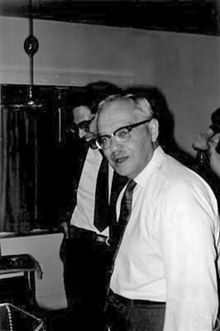Jerzy Neyman
Jerzy Neyman | |
|---|---|
 | |
| Born | April 16, 1894 |
| Died | August 5, 1981 (aged 87) |
| Nationality | Polish, American |
| Alma mater | University of Warsaw Kharkov University |
| Known for | confidence interval, statistics of galaxy clusters |
| Awards | Guy Medal, Fellow of the Royal Society[1] |
| Scientific career | |
| Fields | Mathematics |
| Institutions | Nencki Institute of Experimental Biology University of California, Berkeley |
| Doctoral advisor | Wacław Sierpiński |
| Doctoral students | Wolfgang Bühler Douglas Chapman George Dantzig Lucien Le Cam Erich Leo Lehmann Anastasios Tsiatis Joseph Hodges |
Jerzy Neyman ForMemRS[1] (April 16, 1894 – August 5, 1981), born Jerzy Spława-Neyman, was a Polish mathematician and statistician who spent most of his professional career at the University of California, Berkeley. Neyman was the first to introduce the modern concept of a confidence interval into statistical hypothesis testing.[2]
Life and career
He was born into a Polish family in Bendery, Bessarabia in Imperial Russia, the fourth of four children of Czesław Spława-Neyman and Kazimiera Lutosławska. His family was Roman Catholic and Neyman served as an altar boy during his early childhood. Later, Neyman would become an agnostic. Neyman's family descended from a long line of Polish nobles and military heroes. He graduated from the Kamianets-Podilskyi gubernial gymnasium for boys in 1909 under the name Yuri Cheslavovich Neyman.[3] He began studies at Kharkov University in 1912, where he was taught by Russian probabilist Sergei Natanovich Bernstein. After he read 'Lessons on the integration and the research of the primitive functions' by Henri Lebesgue, he was fascinated with measure and integration.
In 1921 he returned to Poland in a program of repatriation of POWs after the Polish-Soviet War. He earned his Doctor of Philosophy degree at University of Warsaw in 1924 for a dissertation titled "On the Applications of the Theory of Probability to Agricultural Experiments". He was examined by Wacław Sierpiński and Stefan Mazurkiewicz, among others. He spent a couple of years in London and Paris on a fellowship to study statistics with Karl Pearson and Émile Borel. After his return to Poland he established the Biometric Laboratory at the Nencki Institute of Experimental Biology in Warsaw.
He published many books dealing with experiments and statistics, and devised the way which the FDA tests medicines today.
Neyman proposed and studied randomized experiments in 1923.[4] Furthermore, his paper "On the Two Different Aspects of the Representative Method: The Method of Stratified Sampling and the Method of Purposive Selection", given at the Royal Statistical Society on 19 June 1934,[5] was the groundbreaking event leading to modern scientific sampling. He introduced the confidence interval in his paper in 1937.[6] Another noted contribution is the Neyman-Pearson lemma, the basis of hypothesis testing.
In 1938 he moved to Berkeley, where he worked for the rest of his life. Thirty-nine students received their Ph.D's under his advisorship. In 1966 he was awarded the Guy Medal of the Royal Statistical Society and three years later the (American) Medal of Science. He died in Oakland, California.
References
- ^ a b Attention: This template ({{cite doi}}) is deprecated. To cite the publication identified by doi:10.1098/rsbm.1982.0015, please use {{cite journal}} (if it was published in a bona fide academic journal, otherwise {{cite report}} with
|doi=10.1098/rsbm.1982.0015instead. - ^ Salsburg, David (2002). The Lady Tasting Tea: How Statistics Revolutionized Science in the Twentieth Century. Macmillan. p. 122. ISBN 9780805071344.
- ^ Выпускники Каменец-Подольской гимназии 1883-1920
- ^ Neyman, Jerzy. 1923 [1990]. “On the Application of Probability Theory to Agricultural Experiments. Essay on Principles. Section 9.” Statistical Science 5 (4): 465–472. Trans. Dorota M. Dabrowska and Terence P. Speed.
- ^ Neyman, J.(1934) "On the two different aspects of the representative method: The method of stratified sampling and the method of purposive selection", Journal of the Royal Statistical Society, 97 (4), 557–625 JSTOR 2342192
- ^ Neyman, Jerzy (1937). "Outline of a Theory of Statistical Estimation Based on the Classical Theory of Probability". Philosophical Transactions of the Royal Society of London. Series A, Mathematical and Physical Sciences. 236 (767): 333–380. doi:10.1098/rsta.1937.0005. JSTOR 91337.
{{cite journal}}: Unknown parameter|month=ignored (help)
Further references
- Fisher, Ronald "Statistical methods and scientific induction" Journal of the Royal Statistical Society, Series B 17 (1955), 69—78. (criticism of statistical theories of Jerzy Neyman and Abraham Wald)
- Neyman, Jerzy (1956). "Note on an Article by Sir Ronald Fisher". Journal of the Royal Statistical Society, Series B. 18 (2): 288–294. JSTOR 2983716. (reply to Fisher 1955)
- Reid, Constance, Jerzy Neyman—From Life, Springer Verlag, (1982), ISBN 0-387-90747-5
External links
- O'Connor, John J.; Robertson, Edmund F., "Jerzy Neyman", MacTutor History of Mathematics Archive, University of St Andrews
- Jerzy Neyman at the Mathematics Genealogy Project
- ASA biographical article by Chin Long Chiang
- Jerzy Neyman — Biographical Memoirs of the National Academy of Sciences
Statistics of Images of Galaxies with Particular Reference to Clustering
Jerzy Neyman, Elizabeth L. Scott, and C. D. Shane Source: Proc. Third Berkeley Symp. on Math. Statist. and Prob., Vol. 3 (Univ. of Calif. Press, 1956), 75-111.
- National Medal of Science laureates
- Presidents of the Institute of Mathematical Statistics
- Winners of the Wilks Memorial Award
- Winners of the Guy Medal in Gold
- Fellows of the American Statistical Association
- Polish statisticians
- American statisticians
- Survey methodologists
- Kharkiv University alumni
- University of California, Berkeley
- Mathematical analysts
- Polish mathematicians
- American mathematicians
- Philosophers of science
- American philosophers
- American agnostics
- Polish agnostics
- Polish expatriates in Moldova
- Polish expatriates in Russia
- People from Bender, Moldova
- Foreign Members of the Royal Society
- 1894 births
- 1981 deaths
- 20th-century mathematicians
- Members of the Polish Academy of Sciences
- Guggenheim Fellows
